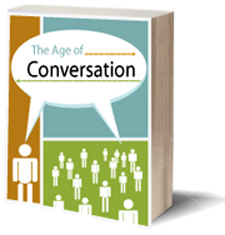 Last year, agency execs Drew McLellan and Gavin Heaton organized 100 influential bloggers from around the world and produced “The Age of Conversation“. The individual essays taken as a group describe how conversations, enabled by social media technology, are transforming the business marketing landscape and how the various marketing disciplines have to change the way they talk to their consumers to be heard.
Last year, agency execs Drew McLellan and Gavin Heaton organized 100 influential bloggers from around the world and produced “The Age of Conversation“. The individual essays taken as a group describe how conversations, enabled by social media technology, are transforming the business marketing landscape and how the various marketing disciplines have to change the way they talk to their consumers to be heard.
This year, McLellan and Heaton decided to do it all aver again with The Age of Conversation 2008 – Why Don’t They Get It? Once again the proceeds from the book go to Variety – the Children’s Charity — which serves children across the entire globe, but unlike last year’s book, this one has more than twice the number of authors, each focusing on one of eight sub-topics:
- Manifestos
- Keeping Secrets in the Age of Conversation
- Moving from Conversation to Action
- The Accidental Marketer
- A New Brand of Creative
- My Marketing Tragedy
- Business Model Evolution
- Life in the Conversation Lane
I contributed a page to Life in the Conversation Lane. Here’s a snippet:
“It’s amazing to watch young children on a playground. They interact and develop friendships with kids they don’t know, share new ideas, expand their imaginations, learn new things through conversation and interaction, experiment, innovate, collaborate to build things and to accomplish goals as a team.”
The new book should be out later this summer. In the meantime, check out the individual blogs of the other contributers:
Adam Crowe, Adrian Ho, Aki Spicer, Alex Henault, Amy Jussel, Andrew Odom, Andy Nulman, Andy Sernovitz, Andy Whitlock, Angela Maiers, Ann Handley, Anna Farmery, Armando Alves, Arun Rajagopal, Asi Sharabi, Becky Carroll, Becky McCray, Bernie Scheffler, Bill Gammell, Bob Carlton, Bob LeDrew, Brad Shorr, Bradley Spitzer, Brandon Murphy, Branislav Peric, Brent Dixon, Brett Macfarlane, Brian Reich, C.C. Chapman, Cam Beck, Casper Willer, Cathleen Rittereiser, Cathryn Hrudicka, Cedric Giorgi, Charles Sipe, Chris Kieff, Chris Cree, Chris Wilson, Christina Kerley (CK), C.B. Whittemore, Clay Parker Jones, Chris Brown, Colin McKay, Connie Bensen, Connie Reece, Cord Silverstein, Corentin Monot, Craig Wilson, Daniel Honigman, Dan Goldstein, Dan Schawbel, Dana VanDen Heuvel, Dan Sitter, Daria Radota Rasmussen, Darren Herman, Darryl Patterson, Dave Davison, Dave Origano, David Armano, David Bausola, David Berkowitz, David Brazeal, David Koopmans, David Meerman Scott, David Petherick, David Reich, David Weinfeld, David Zinger, Deanna Gernert, Deborah Brown, Dennis Price, Derrick Kwa, Dino Demopoulos, Doug Haslam, Doug Meacham, Doug Mitchell, Douglas Hanna, Douglas Karr, Drew McLellan, Duane Brown, Dustin Jacobsen, Dylan Viner, Ed Brenegar, Ed Cotton, Efrain Mendicuti, Ellen Weber, Emily Reed, Eric Peterson, Eric Nehrlich, Ernie Mosteller, Faris Yakob, Fernanda Romano, Francis Anderson, G. Kofi Annan, Gareth Kay, Gary Cohen, Gaurav Mishra, Gavin Heaton, Geert Desager, George Jenkins, G.L. Hoffman, Gianandrea Facchini, Gordon Whitehead, Graham Hill, Greg Verdino, Gretel Going & Kathryn Fleming, Hillel Cooperman, Hugh Weber, J. Erik Potter, J.C. Hutchins, James Gordon-Macintosh, Jamey Shiels, Jasmin Tragas, Jason Oke, Jay Ehret, Jeanne Dininni, Jeff De Cagna, Jeff Gwynne, Jeff Noble, Jeff Wallace, Jennifer Warwick, Jenny Meade, Jeremy Fuksa, Jeremy Heilpern, Jeremy Middleton, Jeroen Verkroost, Jessica Hagy, Joanna Young, Joe Pulizzi, Joe Talbott, John Herrington, John Jantsch, John Moore, John Rosen, John Todor, Jon Burg, Jon Swanson, Jonathan Trenn, Jordan Behan, Julie Fleischer, Justin Flowers, Justin Foster, Karl Turley, Kate Trgovac, Katie Chatfield, Katie Konrath, Kenny Lauer, Keri Willenborg, Kevin Jessop, Kris Hoet, Krishna De, Kristin Gorski, Laura Fitton, Laurence Helene Borei, Lewis Green, Lois Kelly, Lori Magno, Louise Barnes-Johnston, Louise Mangan, Louise Manning, Luc Debaisieux, Marcus Brown, Mario Vellandi, Mark Blair, Mark Earls, Mark Goren, Mark Hancock, Mark Lewis, Mark McGuinness, Mark McSpadden, Matt Dickman, Matt J. McDonald, Matt Moore, Michael Hawkins, Michael Karnjanaprakorn, Michelle Lamar, Mike Arauz, Mike McAllen, Mike Sansone, Mitch Joel, Monica Wright, Nathan Gilliatt, Nathan Snell, Neil Perkin, Nettie Hartsock, Nick Rice, Oleksandr Skorokhod, Ozgur Alaz, Paul Chaney, Paul Hebert, Paul Isakson, Paul Marobella, Paul McEnany, Paul Tedesco, Paul Williams, Pet Campbell, Pete Deutschman, Peter Corbett, Phil Gerbyshak, Phil Lewis, Phil Soden, Piet Wulleman, Rachel Steiner, Sreeraj Menon, Reginald Adkins, Richard Huntington, Rishi Desai, Beeker Northam, Rob Mortimer, Robert Hruzek, Roberta Rosenberg, Robyn McMaster, Roger von Oech, Rohit Bhargava, Ron Shevlin, Ryan Barrett, Ryan Karpeles, Ryan Rasmussen, Sam Huleatt, Sandy Renshaw, Scott Goodson, Scott Monty, Scott Townsend, Scott White, Sean Howard, Sean Scott, Seni Thomas, Seth Gaffney, Shama Hyder, Sheila Scarborough, Sheryl Steadman, Simon Payn, Sonia Simone, Spike Jones, Stanley Johnson, Stephen Collins, Stephen Cribbett, Stephen Landau, Stephen Smith, Steve Bannister, Steve Hardy, Steve Portigal, Steve Roesler, Steven Verbruggen, Steve Woodruff, Sue Edworthy, Susan Bird, Susan Gunelius, Susan Heywood, Tammy Lenski, Terrell Meek, Thomas Clifford, Thomas Knoll, Tiffany Kenyon, Tim Brunelle, Tim Buesing, Tim Connor, Tim Jackson, Tim Longhurst, Tim Mannveille, Tim Tyler, Timothy Johnson, Tinu Abayomi-Paul, Toby Bloomberg, Todd Andrlik, Troy Rutter, Troy Worman, Uwe Hook, Valeria Maltoni, Vandana Ahuja, Vanessa DiMauro, Veronique Rabuteau, Wayne Buckhanan, William Azaroff, Yves Van Landeghem
 Make a claim which is true only because of a small disclaimer. Then, repeated it to the point that people take it on face value. Its one of the oldest marketing ploys in the book and it’s what AT&T is doing with their “More Bars in More Places” campaign. You’ve seen them. TV ads that present a humorous situation, often based in the US, where someone isn’t receiving an important call because they don’t have AT&T. The disclaimer at the bottom clarifies that “More Bars in More Places than any other Network” is based on Global coverage. So yes, technically AT&T has more bars in more places, but does the target domestic audience really care that I can get AT&T Wireless coverage outside of the US. I don’t think so. Without the disclaimer, their domestic coverage does not live up to the claim. From Ad Age:
Make a claim which is true only because of a small disclaimer. Then, repeated it to the point that people take it on face value. Its one of the oldest marketing ploys in the book and it’s what AT&T is doing with their “More Bars in More Places” campaign. You’ve seen them. TV ads that present a humorous situation, often based in the US, where someone isn’t receiving an important call because they don’t have AT&T. The disclaimer at the bottom clarifies that “More Bars in More Places than any other Network” is based on Global coverage. So yes, technically AT&T has more bars in more places, but does the target domestic audience really care that I can get AT&T Wireless coverage outside of the US. I don’t think so. Without the disclaimer, their domestic coverage does not live up to the claim. From Ad Age:


